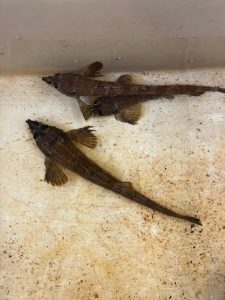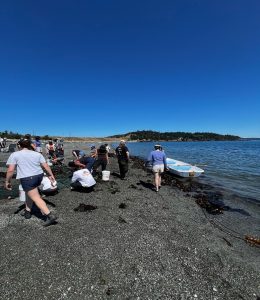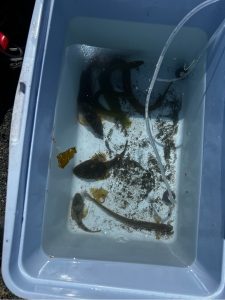Armor for defense or mobility? Recent graduate investigates poacher fish armor at FHL
Bryan Lemus, a recent Marine Biology graduate from the University of Washington, worked with a team at Friday Harbor Labs (FHL) studying armored fishes. The team studies poacher fishes (Agonidae), which are small, bottom-dwelling, cold-water marine fishes covered in dense armor from head to tail.

There are 47 different species of poachers, each with unique armor shape, size, and surface texture. Bryan has been working with UW Biology graduate student, Megan Vandenberg, to measure specific features of this armor, including overlap, spine height, and scale row count. The goal of this research is to understand the extent of the variation, and eventually to determine if shape influences the tradeoff between swimming performance and protection from predators.
Bryan looks at poacher armor using micro-computed tomography (CT) scans of the fish with a program called 3D Slicer. This program allows him to look at high resolution 3D renderings of armor plates as well as collect and record measurements. Understanding how overlap and morphology vary will allow researchers to make predictions about bending stiffness and range of motion in poacher bodies. These metrics in turn will increase their understanding of how different poacher species handle the tradeoff between swimming and defense.
In addition to measuring poacher armor, Bryan has also been working with Dr. Cassandra Donatelli, a professor at the University of Washington Tacoma, on a project called MorphoCloud. The goal of this project is to make working with CT scans accessible to more people. CT scans are very large, so researchers who want to use them typically need a powerful computer. MorphoCloud is a platform which allows users to offload that processing onto an external cluster, drastically decreasing the computational requirements for working with these data.

While studying at FHL during Autumn 2024, Bryan attended a seminar where Dr. Donatelli spoke about her research on kinematics and morphology and he was hooked! “I found it really interesting and was super engulfed on the different ways of testing and different methods on creating models, and so I spoke to Dr. Donatelli after the seminar,” Bryan said. “She was very welcoming and allowed me to assist on some projects, plus she introduced me to Megan Vanderberg and many more researchers that I have learned so much from.”
Bryan hopes to continue contributing to these projects, but more importantly, he hopes to carry forward the skills he has gained and pursue an independent research path. Ultimately, his goal is to earn a PhD and continue asking meaningful scientific questions throughout his career.
- Carrying out a beach sein at Jackson Beach.
- Fish caught at a beach sein at Jackson Beach.

